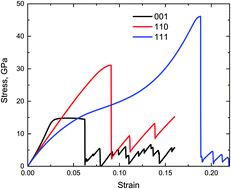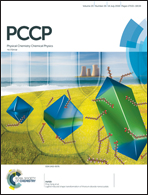Twin and dislocation mechanisms in tensile W single crystal with temperature change: a molecular dynamics study†
Abstract
Molecular dynamics simulations are performed to investigate the orientation and temperature dependence of tensile response in single crystal W. It is found that W single crystal exhibits distinct temperature-dependent deformation behaviors along different orientations. With increasing temperature, the yield strain in the [001] orientation increases, while those in [110] and [111] orientations first increase and then decrease. The tensile deformations along orientations close to [001] are found to be dominated by twinning; the nucleation and growth of twins are accomplished through the nucleation and glide of ⅙〈111〉 partial dislocations on {112} planes. In contrast, the deformations along orientations close to [110] and [111] are found to be dominated by the slip of ½〈111〉 full dislocations, which move in a stay-and-go fashion. Moreover, intermediate deformation behaviors, which may become unstable at high temperatures, are observed for some intervening orientations. The distinct deformation behaviors of W along different orientations are rationalized based on the twinning–antitwinning asymmetry of ⅙〈111〉 partial dislocations on {112} planes.


 Please wait while we load your content...
Please wait while we load your content...